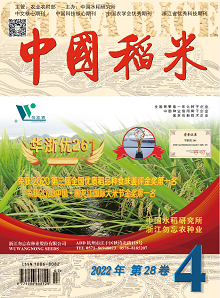Using peat, vermiculite and paddy soil as raw materials to mix different rice nursery substrates (CK, 100% paddy soil; T1, 50% paddy soil+50% peat; T2, 50% paddy soil+30% peat+20% vermiculite; T3, 25% paddy soil+75% peat; T4, 25% paddy soil+50% peat+25% vermiculite; T5, 33.3% paddy soil+33.3% peat+33.3%verniculte), the physicochemical properties of different nursery substrates and their effects on rice seedling quality, machine transplanting performance and blanket weight reduction were studied, and the suitable nursery substrates for rice seedling raising in Guangdong was screened out. The results showed that compared with CK, the mixed substrates significantly improved soil aeration pore and container capacity, decreased the bulk density by 34.16%-57.25%, and increased the total porosity by 9.99%-15.82%. Except for T3, the mixed substrates all had the effect of strengthening seedlings, and T4 had the best effect, followed by T5. The plant height, the dry matter mass of 100 plants, and the root binding capacity of T4 were increased by 24.49%, 31.79% and 26.11%, respectively, compared with CK. The seedling quality of T4 and T5 was the best. The adult seedling rate and sound seedling index of T4 and T5 were significantly improved by 16.63%-17.91% and 30.00%-36.57% compared with CK, respectively, and the weight of the carpet seedlings was reduced by 20.52%-22.43%. The planting quality of T4 and T5 was the best, the number of seedlings per hill was 1.31-1.34 times that of CK, and the missing seedlings rate, floating seedlings rate and injured seedling rate were 3.48%-3.97%, 2.28%-2.46%, and 1.93%-2.69% lower than those of CK, respectively. In conclusion, the better seedling nursery substrate of rice were T4 and T5 under the conditions of this experiment.

